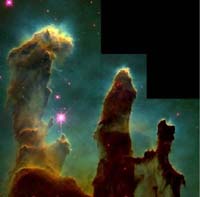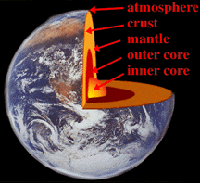| |
In the BeginningThe whole Solar System developed from a cloud of dust and gas called a nebula. Scientists believe that all the stars in the Universe formed from a nebula that collects together through the force of gravity. Astronomers believe that at the beginning of the Universe most of the matter that existed was in the form of hydrogen. The hydrogen atom is the simplest atom that exists: it has one proton and one electron . Element Factory If most of the matter that existed was once hydrogen how did oxygen, nitrogen, iron, calcium and the rest of the elements develop? Good question! The Power of AttractionIn the beginning, the universe was a bunch of gas and dust spreading out in space. Over a very long time, this gas and dust started gathering together into clumps, or clouds through the force of gravity. In everything that exists, every atom has a gravitational pull that wants to attract something to it. As matter collects together, its gravitational pull gets stronger and it can reach out farther to grab more matter. That increases its gravitational pull even more. This process continues until there is nothing more to grab. |
Get the picture?This gravity feeding frenzy will continue until there is no more matter nearby to pull in. |
Let's Get TogetherIf the blob of stuff gets big enough, it forms a sphere or ball. The center of gravity of the sphere is in the middle. Everything is being pulled towards the very center of the sphere. If enough material is pulled toward the center, the weight of the outer parts crush the inner parts and cause the atoms to fuse, or join together to become newer, more complex atoms. This process is called fusion. What About the Leftovers?Whatever parts are not used to make the new atom are released as heat and light energy. Whenever atoms are fused or split, they release a lot of energy. That is how atom bombs work. That is also how stars works. Stars are not on fire in space, they are constantly having nuclear explosions. This is what makes them shine. Here Comes the Sun
Solar Winds | Density of the Planets
|
Formation of the Earth
Collision CourseVery early on in our Solar System’s history, there were many more planets than there are today, though they were all smaller than today’s planets. The nine planets (and their moons) are the bodies that ‘won’ the collision contest. The collisions haven’t stopped, they have just slowed down and most of the larger planet-sized chunks have been swallowed up (thank goodness, as you will see). MeteorsApproximately ten tons of new material enter the Earth's atmosphere every day. Most of this debris is the size of a grain of sand or a small pebble and burns up harmlessly in the atmosphere. At night the debris is often visible as shooting stars. Scientists call these pieces of planet building material that burn up in our atmosphere, meteors. After they burn up on entry into the earth’s atmosphere, their dust settles on the surface of the Earth. MeteoritesSometimes larger chunks survive the burning trip through the atmosphere and hit the surface of the Earth. These are called meteorites. Fortunately, most of our planet’s surface is ocean, so meteorites tend to land harmlessly out at sea. On rare occasions, city sized chunks of rock and/or ice slam into Earth and cause massive destruction. Scientists believe a large meteorite that hit the Yucatan Peninsula in the Gulf of Mexico 65 million years ago at the end of the Cretaceous period led to the extinction of the dinosaurs. They think that when the meteorite hit the Earth, it sent huge quantities of dust, smoke and debris into the atmosphere all over the world. The dust, smoke and debris blocked the Sun for many weeks or months. This caused temperatures to drop all over the planet, causing winter like conditions everywhere. Plants and animals that couldn't adapt to the sudden changes in light and temperature died, and animals that depended on these organisms for food, like the dinosaurs, eventually died as well. FrictionThe friction of huge impacts creates heat. The relentless pounding the early Earth took generated so much heat that it melted the entire planet into liquid rock. Yup, the Earth was a floating ball of lava in space! Feel the HeatTry the simple experiment of rubbing your hands together briskly for ten to twenty seconds and feel the heat generated from this relatively miniscule amount of friction. | Forming Layers
The core separated into a solid inner core consisting mainly of iron and nickel. The inner core is surrounded by a liquid metal outer core that generates an electrical current as the Earth rotates. This spinning electrical current is responsible for the magnetic field that surrounds our planet. This magnetic field protects us from some of the more deadly forms of solar radiation by deflecting those harmful rays towards the North and South Magnetic Poles and in doing so, create the Northern and Southern Lights. As the bombardment of larger chunks slowed down, the exterior of the earth had a chance to cool and harden into a crust as it was exposed to the coldness of outer space (there was no atmosphere in the early part of the Earth formation). The mantle stayed molten because the crust served as insulation retained the heat generated from radioactive materials in the Earth’s interior. The mantle doesn’t just sit there, it is in constant roiling motion due to convection of the liquid rock. The term ‘liquid’ here is slightly misleading. A more accurate description of the consistency of the earth’s mantle just below the crust is more like that of a taffy that is sticky enough to grab a hold of the rough and uneven underside of the crust and pull the crust along with it. This constant tugging at the underside of the crust by a thick, sticky substance sometimes results in separation or rupturing of the crust which might allow for the liquid rock to ooze through to the surface. But that story belongs in the section on Plate Tectonics.
Creation of the Moon
|


 Stars may not be alive in the same way that we are, but they do have a beginning, a middle and an end to their existence. It just happens that a star’s lifetime is measured in many millions or billions of years. Since we tend to hang out around in life for less than a century, stars seem unchanging to us.
Stars may not be alive in the same way that we are, but they do have a beginning, a middle and an end to their existence. It just happens that a star’s lifetime is measured in many millions or billions of years. Since we tend to hang out around in life for less than a century, stars seem unchanging to us. 

 When our Sun formed from a nebula in this region of space, it gobbled up nearly all of the material for itself. The key word here is “nearly”, which means that some material was left over after the Sun was created. However, if the mass of the solar system was converted into one dollar, the Sun would be worth more than 99 cents, and all the planets, moons, asteroids and comets put together would total less than one penny!
When our Sun formed from a nebula in this region of space, it gobbled up nearly all of the material for itself. The key word here is “nearly”, which means that some material was left over after the Sun was created. However, if the mass of the solar system was converted into one dollar, the Sun would be worth more than 99 cents, and all the planets, moons, asteroids and comets put together would total less than one penny!
 This explains why the inner planets of Mercury, Venus, Earth and Mars are dense, rocky planets and the outer planets of Jupiter, Saturn, Uranus (which, by the way, is properly pronounced ’YUR-uh-nis’) and Neptune are gas giants. Pluto, while still called a planet, resembles more closely the body of objects being classified as Kuiper Belt Objects. These distant objects are more like giant comets and are apparently made of materials light enough to be blown out past Neptune’s orbit.
This explains why the inner planets of Mercury, Venus, Earth and Mars are dense, rocky planets and the outer planets of Jupiter, Saturn, Uranus (which, by the way, is properly pronounced ’YUR-uh-nis’) and Neptune are gas giants. Pluto, while still called a planet, resembles more closely the body of objects being classified as Kuiper Belt Objects. These distant objects are more like giant comets and are apparently made of materials light enough to be blown out past Neptune’s orbit.
 Seeing that New Hampshire is located on Earth, let’s concentrate now on our planet’s development. Earth is one of the inner planets and is made up of the denser (heavier) elements that were left over after the Sun was formed. The current accepted theory for planet development is known as the
Seeing that New Hampshire is located on Earth, let’s concentrate now on our planet’s development. Earth is one of the inner planets and is made up of the denser (heavier) elements that were left over after the Sun was formed. The current accepted theory for planet development is known as the 



No comments:
Post a Comment